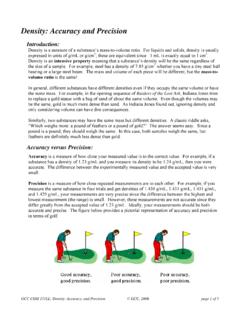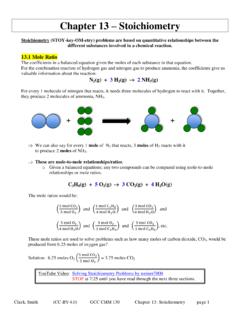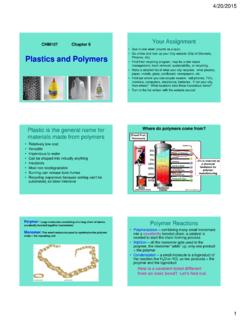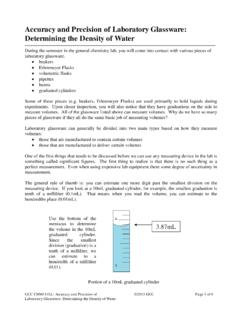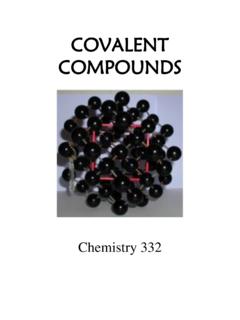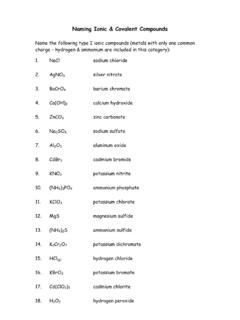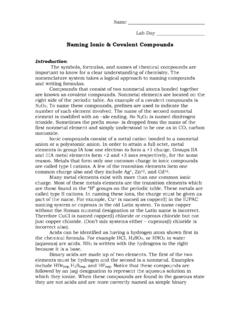Transcription of Chapter 7 Practice Worksheet: Covalent Bonds and Molecular ...
1 Name: __KEY_____ Section: _____ Chapter 7 worksheet Spring 2007 page 1 of 5 Chapter 7 Practice worksheet : Covalent Bonds and Molecular Structure 1) How are ionic Bonds and Covalent Bonds different? Ionic Bonds result from the transfer of electrons from one atom to another; Covalent Bonds result from two atoms sharing electrons. 2) Describe the relationship between the length of a bond and the strength of that bond . Strength of a bond increases as the bond gets shorter (inverse relationship) 3) Identify the type(s) of bond (s) found in the following molecules: a. CCl4 ___covalent_____ b. Li2O ___ionic_____ c. NF3 ___covalent_____ d. CaSO4 ___ionic and covalent_____ e. SO2 ___covalent_____ f. Mg(OH)2 ___ionic and covalent_____ 4) Define electronegativity. Electronegativity is the ability for an atom in a molecule to attract electrons to itself. 5) Use electronegativity values to place the following elements in increasing order: F, N, H, P, Si, C, O Si < H = P C < N < O < F 6) Determine if the bond between atoms in each example below is nonpolar Covalent , polar Covalent , or ionic.
2 A. H2 ___npc_____ b. PCl ___pc_____ c. F2 ___npc_____ d. NaBr ___ionic_____ e. NF __pc_____ f. MgO __ionic_____ g. CH __npc_____ h. HCl __pc_____ Name: __KEY_____ Section: _____ Chapter 7 worksheet Spring 2007 page 2 of 5 7) Draw Lewis Structures for the following molecules: (the descriptions below indicate the number and types of Bonds on central atoms (first one listed except in H2O; outer atoms have complete octets with lone pairs) a. CO2 (double Bonds from C to each O, no lone pairs) b. BeCl2 (single bond to each Cl, no lone pairs) c. H2O (single bond to O, 2 lone pairs on O) d. BF3 (single Bonds to F, no lone pairs) e. CCl4 (single Bonds to Cl, no lone pairs) f. NH3 (single Bonds to H, 1 lone pair on N) g. NO3- (2 single Bonds , 1 double bond , no lone pairs) h. SO3 (2 single Bonds , 1 double bond , no lone pairs) i. SO32- (3 single Bonds , 1 lone pair) j. NF3 (3 single Bonds , 1 lone pair) k.
3 CO (triple bond , lone pair on C and O) l. O3 (1 single bond , 1 double bond , 1 lone pair) m. CO32- (2 single Bonds , 1 double bond ) n. SO2 (1 single bond , 1 double bond , 1 lone pair) o. PF5 (5 single Bonds , no lone pairs) p. PCl5 (5 single Bonds , no lone pairs) q. SF6 (6 single Bonds , no lone pairs) r. TeF6 (6 single Bonds , no lone pairs) 8) Which of the above compounds (in number 7) require resonance structures to describe the structure properly? Draw them. g, h, l, m, and n Name: __KEY_____ Section: _____ Chapter 7 worksheet Spring 2007 page 3 of 5 9) Which of the above compounds (in number 7) are exceptions to the octet rule? b, d, o, p, q, r 10) Fill in the table below to determine the Molecular geometry for the following molecules: Formula ABE formula Number of e- domains on central atom # e- domains/ # non-bonding domains on central atom Electron-Domain Geometry (name) Molecular Geometry (name) bond angle(s) on central atom CO2 AB2 2 2 / 0 Linear Linear 180o BeCl2 AB2 2 2 / 0 Linear Linear 180o H2O AB2E2 4 2 / 2 Tetrahedral Bent < BF3 AB3 3 3 / 0 Trigonal planar Trigonal planar 120o CCl4 AB4 4 4 / 0 Tetrahedral Tetrahedral NH3 AB3E1 4 3 / 1 Tetrahedral Trigonal pyramidal < NO3- AB3 3 3 / 0 Trigonal planar Trigonal planar 120o SO3 AB3 3 3 / 0 Trigonal planar Trigonal planar 120o SO32- AB3E1 4 3 / 1 Tetrahedral Trigonal pyramidal < NF3 AB3E1 3 3 / 1 Tetrahedral Trigonal pyramidal < Name: __KEY_____ Section.
4 _____ Chapter 7 worksheet Spring 2007 page 4 of 5 Formula ABE formula Number of e- domains on central atom # e- domains/ # non-bonding domains on central atom Electron-Domain Geometry Molecular Geometry (name) bond angle(s) on central atom CO AB1E1 2 1 / 1 Linear Linear 180o O3 AB2E1 3 2 / 1 Trigonal planar Bent <120o CO32- AB3 3 3 / 0 Trigonal planar Trigonal planar 120o SO2 AB2E1 3 2 / 1 Trigonal planar Bent <120o PF5 AB5 5 5 / 0 Trigonal bipyramidal Trigonal bipyramidal 120o and 90o PCl5 AB5 5 5 / 0 Trigonal bipyramidal Trigonal bipyramidal 120o and 90o SF6 AB6 6 6 / 0 Octahedral Octahedral 90o TeF6 AB6 6 6 / 0 Octahedral Octahedral 90o 11) a. Identify the molecules in the table above that are polar. H2O, NH3, SO32-, NF3, CO, O3, SO2 b. How many nonbonding pairs of electrons did the polar molecules have? __1 or 2_____ c. How many nonbonding pairs of electrons did the nonpolar molecules have? __none_____ 12) Give one example of a polar molecule that has nonpolar Bonds .
5 ___O3_____ Give one example of a nonpolar molecule that has polar Bonds . ___CCl4_____ Name: __KEY_____ Section: _____ Chapter 7 worksheet Spring 2007 page 5 of 5 13) Indicate the hybridization of the central atom. Also indicate the total number of sigma ( ) and pi ( ) Bonds in the following molecules. Formula Hybridization of central atom # of Bonds # of Bonds CO2 sp 2 2 BeCl2 sp 2 0 H2O sp3 2 0 BF3 sp2 3 0 CCl4 sp3 4 0 NH3 sp3 3 0 NO3- sp2 3 1 SO3 sp2 3 1 SO32- sp3 3 0 NF3 sp3 3 0 CO sp 1 2 O3 sp2 2 1 CO32- sp2 3 1 SO2 sp2 2 1 PF5 sp3d 5 0 PCl5 sp3d 5 0 SF6 sp3d2 6 0 TeF6 sp3d2 6 0




